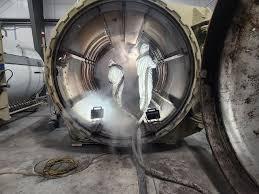Why Dry Ice Blasting Is Changing the Way Industries Clean
How a powerful, non-damaging, and eco-friendly method is replacing outdated cleaning techniques across sectors
Industrial cleaning is no longer just about removing dirt and grime. In today’s world, it also means protecting the environment, minimizing equipment wear, reducing downtime, and ensuring worker safety. With these priorities in mind, more industries are turning to an innovative method that checks all the boxes: dry ice blasting.
This advanced cleaning technology is revolutionizing the way businesses maintain equipment, remove contaminants, and prepare surfaces—all without water, chemicals, or abrasion. But what exactly makes dry ice blasting so effective, and why is it gaining such widespread adoption?
How Dry Ice Blasting Works
Dry ice blasting operates using solid carbon dioxide (CO₂), commonly referred to as dry ice. These CO₂ pellets are propelled at high velocity using compressed air. Upon contact with a surface, the pellets instantly change from solid to gas in a process called sublimation.
This rapid phase transition creates a microscopic explosion at the point of impact, which lifts dirt, oil, paint, and other unwanted materials from the surface. Three forces work simultaneously: the kinetic energy of the pellets, the thermal shock from the extreme cold, and the expanding gas that lifts debris away. Because the dry ice evaporates on contact, it leaves no residue or moisture behind—only a clean surface.
Why Industries Prefer Dry Ice Blasting
The advantages of dry ice blasting over traditional methods are clear. First, it is completely dry, which means it can be used on sensitive electrical components, printed circuit boards, and delicate machinery without risk of short circuits or corrosion. Unlike pressure washing or chemical solvents, there’s no need to wait for surfaces to dry or worry about hazardous run-off.
Second, it is non-abrasive. This makes it ideal for cleaning intricate equipment, painted surfaces, or heritage materials that could be damaged by sandblasting or wire brushing. For companies in automotive, aerospace, and electronics, this is a major benefit.
Third, dry ice blasting doesn’t require disassembly. Because the process is safe and precise, machines can often be cleaned in place. This saves hours—or even days—of downtime and labor, improving efficiency and lowering costs.
Where Dry Ice Blasting Makes the Biggest Impact
Dry ice blasting is now being used in a wide range of industries, from food production and medical manufacturing to shipbuilding and power generation.
In food and beverage plants, hygiene is critical. Dry ice blasting eliminates mold, bacteria, and built-up food residues from ovens, mixers, and conveyors—without water or cleaning chemicals. This reduces contamination risk and ensures compliance with health regulations.
In automotive facilities, dry ice blasting is used to clean engines, transmissions, molds, and welding robots. It removes grease and grime without harming wiring or seals. In aerospace and electronics, where precision is everything, it cleans without static, moisture, or surface damage.
Even restoration contractors rely on this method to remove smoke, mold, and soot from fire-damaged buildings and materials. Since it’s non-toxic and doesn’t release harmful fumes, it’s safe for use in occupied spaces or sensitive environments.
Environmental and Safety Benefits
Dry ice blasting is also praised for its sustainability. The dry ice used in the process is typically sourced from recycled CO₂ captured during industrial manufacturing. Instead of adding new carbon dioxide to the atmosphere, the process simply repurposes existing gas.
Because it produces no liquid waste, no chemical residue, and no secondary media like sand or grit, it significantly reduces disposal costs and environmental impact. Workers also benefit from a cleaner and safer work environment with fewer airborne pollutants or chemical exposures.
Ventilation is important, however. Since CO₂ can displace oxygen in enclosed spaces, the process must be conducted in well-ventilated areas or with proper gas monitoring systems in place. Operators should also wear appropriate protective gear, including eye and hearing protection.
When Dry Ice Blasting Isn’t the Right Fit
Despite its many advantages, dry ice blasting isn’t ideal for every situation. It’s not recommended for very soft or porous materials that could crack under cold temperatures or pressure. It also requires access to dry ice and high-pressure air, which may not be practical in remote locations or small-scale operations.
The initial cost of equipment can also be a factor, though many companies offer mobile services or equipment rentals to make it more accessible.
Why This Technology Is Here to Stay
As industries demand cleaner, safer, and faster solutions, dry ice blasting continues to gain ground. It reduces water usage, eliminates harsh chemicals, lowers downtime, and improves equipment lifespan—all while delivering an exceptional clean.
Whether it’s extending the life of a food production line, restoring delicate structures, or preparing aircraft components for inspection, dry ice blasting offers a versatile and future-forward approach to industrial cleaning.
In a world moving toward greener practices and smarter technology, dry ice blasting is not just a trend—it’s the next standard.

